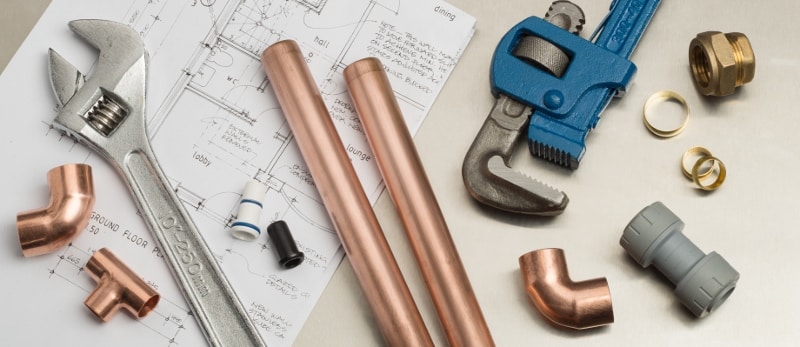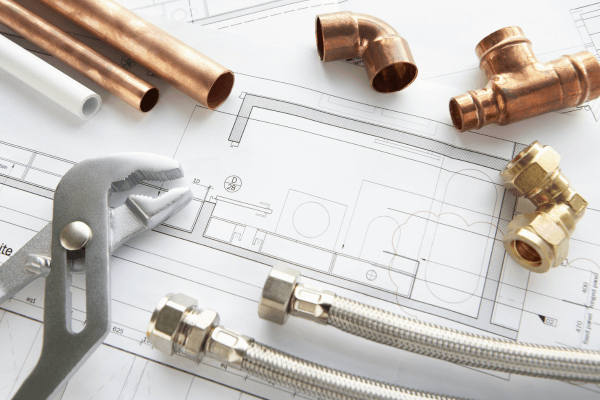Important Parts of Your House's Plumbing System
Important Parts of Your House's Plumbing System
Blog Article
Do you find yourself interested in info on The Inner Workings of Your Home's Plumbing?

Comprehending exactly how your home's pipes system functions is crucial for each home owner. From delivering clean water for drinking, cooking, and bathing to safely eliminating wastewater, a properly maintained pipes system is critical for your family members's health and comfort. In this extensive guide, we'll check out the intricate network that makes up your home's plumbing and deal tips on maintenance, upgrades, and dealing with usual issues.
Introduction
Your home's plumbing system is more than just a network of pipes; it's a complex system that guarantees you have accessibility to tidy water and reliable wastewater elimination. Recognizing its elements and exactly how they collaborate can assist you prevent costly repairs and guarantee every little thing runs smoothly.
Basic Components of a Plumbing System
Pipes and Tubes
At the heart of your pipes system are the pipelines and tubes that bring water throughout your home. These can be made from various materials such as copper, PVC, or PEX, each with its advantages in regards to sturdiness and cost-effectiveness.
Fixtures: Sinks, Toilets, Showers, and so on.
Fixtures like sinks, toilets, showers, and bathtubs are where water is made use of in your house. Comprehending exactly how these fixtures connect to the pipes system aids in identifying issues and intending upgrades.
Shutoffs and Shut-off Factors
Shutoffs regulate the flow of water in your plumbing system. Shut-off valves are essential during emergency situations or when you require to make repair work, allowing you to separate parts of the system without interfering with water circulation to the entire residence.
Water System
Key Water Line
The major water line connects your home to the community water system or an exclusive well. It's where water enters your home and is distributed to various components.
Water Meter and Pressure Regulatory Authority
The water meter actions your water use, while a stress regulatory authority guarantees that water streams at a safe pressure throughout your home's pipes system, protecting against damage to pipes and components.
Cold Water vs. Warm water Lines
Understanding the difference in between cold water lines, which supply water directly from the major, and hot water lines, which lug warmed water from the water heater, aids in fixing and preparing for upgrades.
Drain System
Drain Piping and Traps
Drain pipes bring wastewater far from sinks, showers, and bathrooms to the drain or septic tank. Catches avoid sewage system gases from entering your home and likewise catch debris that can trigger clogs.
Air flow Pipelines
Ventilation pipelines permit air right into the water drainage system, preventing suction that can slow down drainage and create traps to vacant. Correct ventilation is essential for preserving the integrity of your pipes system.
Significance of Proper Water Drainage
Guaranteeing correct drain prevents back-ups and water damage. Consistently cleaning drains pipes and preserving catches can stop expensive repair work and expand the life of your plumbing system.
Water Furnace
Kinds Of Hot Water Heater
Water heaters can be tankless or traditional tank-style. Tankless heating units warm water on demand, while containers keep warmed water for instant use.
Upgrading Your Plumbing System
Reasons for Updating
Upgrading to water-efficient fixtures or replacing old pipes can enhance water high quality, reduce water bills, and enhance the worth of your home.
Modern Plumbing Technologies and Their Advantages
Explore innovations like clever leak detectors, water-saving bathrooms, and energy-efficient water heaters that can save cash and reduce ecological influence.
Expense Considerations and ROI
Determine the in advance prices versus long-term cost savings when considering plumbing upgrades. Lots of upgrades pay for themselves with minimized utility expenses and less fixings.
How Water Heaters Link to the Pipes System
Recognizing just how water heaters attach to both the cold water supply and hot water distribution lines assists in detecting issues like inadequate warm water or leakages.
Upkeep Tips for Water Heaters
Frequently flushing your hot water heater to get rid of sediment, checking the temperature level setups, and evaluating for leakages can expand its life expectancy and boost power efficiency.
Common Plumbing Problems
Leakages and Their Reasons
Leakages can occur due to aging pipes, loosened installations, or high water stress. Addressing leaks without delay prevents water damage and mold growth.
Clogs and Blockages
Clogs in drains and bathrooms are typically triggered by flushing non-flushable products or a build-up of oil and hair. Making use of drainpipe screens and being mindful of what drops your drains pipes can prevent blockages.
Indications of Pipes Issues to Expect
Low tide stress, sluggish drains pipes, foul odors, or uncommonly high water costs are indications of prospective pipes issues that must be attended to immediately.
Plumbing Upkeep Tips
Routine Examinations and Checks
Set up yearly pipes assessments to catch issues early. Search for signs of leaks, deterioration, or mineral build-up in taps and showerheads.
DIY Maintenance Tasks
Straightforward jobs like cleaning faucet aerators, checking for bathroom leaks using color tablet computers, or protecting subjected pipes in cold environments can protect against significant plumbing issues.
When to Call a Professional Plumbing Professional
Know when a plumbing issue calls for expert knowledge. Trying complicated repair work without proper expertise can result in even more damages and higher repair prices.
Tips for Minimizing Water Usage
Simple behaviors like taking care of leaks quickly, taking shorter showers, and running full lots of laundry and meals can conserve water and reduced your energy expenses.
Eco-Friendly Plumbing Options
Take into consideration sustainable plumbing products like bamboo for flooring, which is durable and eco-friendly, or recycled glass for counter tops.
Emergency Readiness
Actions to Take Throughout a Plumbing Emergency situation
Know where your shut-off valves lie and just how to shut off the water supply in case of a ruptured pipe or significant leak.
Relevance of Having Emergency Contacts Helpful
Keep call information for neighborhood plumbing professionals or emergency services conveniently available for fast reaction throughout a plumbing situation.
Environmental Influence and Conservation
Water-Saving Components and Appliances
Setting up low-flow taps, showerheads, and toilets can substantially reduce water use without compromising performance.
Do It Yourself Emergency Fixes (When Suitable).
Temporary repairs like making use of duct tape to spot a dripping pipe or positioning a bucket under a leaking tap can minimize damage up until a specialist plumber arrives.
Final thought.
Recognizing the anatomy of your home's pipes system encourages you to maintain it efficiently, saving money and time on repairs. By following routine upkeep routines and staying notified concerning modern plumbing innovations, you can guarantee your plumbing system runs efficiently for many years to find.
The Anatomy of Your Home s Plumbing System
Understanding the anatomy of your home s plumbing system is essential for any homeowner. It not only helps in identifying potential issues but also facilitates effective communication with professionals when repairs or upgrades are needed. Your home s plumbing system is more than just pipes and faucets; it s a complex network that ensures the efficient and hygienic flow of water in and out of your house. In this blog, we ll dissect the crucial components of your home s plumbing system. For those in Antelope Valley, Brock Plumbing is your trusted partner for all your plumbing needs, ensuring your system functions smoothly and efficiently.
Water Supply System
Main Water Line: This is where your home s plumbing system begins. The main water line connects your home to the public water supply or a private well. Pipes and Shut-off Valves: Pipes distribute water throughout your home. Shut-off valves are crucial for controlling the flow of water and making repairs without shutting off the entire system. Drainage System
Drain Pipes: These pipes carry waste and water away from sinks, toilets, and showers. Vents: Vents allow sewer gases to escape and help maintain proper pressure in the drainage pipes, ensuring efficient flow of wastewater. Traps: Every fixture has a trap, a U-shaped pipe that holds water and prevents sewer gases from entering your home. The most common is the P-trap under sinks. Fixtures and Appliances
Fixtures and appliances are the most interacted with parts of your plumbing system. They include sinks, toilets, showers, dishwashers, and washing machines. Each fixture and appliance has its own supply and drainage connection, ensuring they receive clean water and can dispose of wastewater effectively.
Water Heating System
Your water heater is a crucial component, providing hot water to various fixtures and appliances in your home. It can be tank-based or tankless, with each type having its own set of advantages and maintenance requirements. Regular maintenance is essential to ensure efficient operation and extend the lifespan of the unit.
Sump Pump
In areas prone to flooding or with high water tables, a sump pump is an essential part of the plumbing system. It s installed in the lowest part of your basement or crawlspace and pumps out water that accumulates, preventing flooding and protecting your home from water damage.
Septic System
Homes that are not connected to a municipal sewer system have a septic system and an underground wastewater treatment structure. Understanding how to maintain your septic system is crucial to prevent backups, odors, and early system failure.
Conclusion
Your home s plumbing system is a complex and essential network, ensuring the efficient and hygienic flow of water in and out of your property. Understanding its key components helps in maintaining it properly and identifying issues before they escalate into major problems. For residents in Antelope Valley, Brock Plumbing is dedicated to providing top-notch services, ensuring that every part of your plumbing system is in perfect working order. Trust our team of professionals to handle all your plumbing needs, ensuring your home remains comfortable, safe, and well-maintained.
https://brockplumbinganddrains.com/blog/the-anatomy-of-your-homes-plumbing-system/

I was shown that write-up on Anatomy of a House: Understanding the Components from an acquaintance on a different domain. Appreciated our blog? Please quickly share it. Help somebody else locate it. Thanks for going through it.
Set An Appointment Report this page